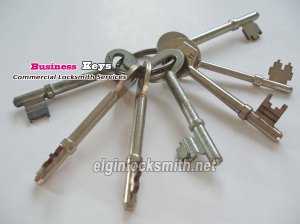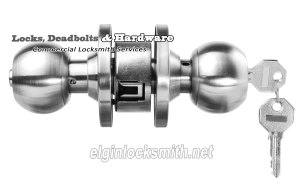When you’re shopping for locks for your home or business, you’ll find an almost endless selection of various types of locks. You’ll need to think about many factors: your security needs, your cost, and then customizing the lock for the particular space as well as for the specific user(s).

Let’s take a look at some popular kinds of locks and consider their security features:
Deadbolts are usually viewed as one of the safest and most secure locks you can get for your home. They’re called “dead” because there are no springs to operate the bolt; a deadbolt is operated only manually ~ with a key or a thumbturn.
Deadbolts are installed on external doors in four types: single-cylinder, double-cylinder, lockable thumbturn, and jimmy-proof.
- Single-cylinder deadbolts are what we usually imagine, having a key cylinder on the outside, and a thumbturn on the inside to open or close it. They’re usually used on solid metal or wood doors. The one drawback to this kind is that if there’s any possible access to the inside (such as through a nearby window, or even through the peephole, which a professional burglar will know how to do using simple tools), the door can be opened using the thumbturn.
- To solve this problem, a double-cylinder deadbolt has a key cylinder both on the inside and on the outside of the door. Therefore, the double-cylinder always requires a key to open the door from the inside if it’s locked. It’s good for a door with glass, or for a door with a window nearby, since it prevents someone from breaking the glass and reaching in to unlock the door. Its disadvantage is that this can be unsafe in case of fire. If used in a residence, you ought to make sure there’s a key left on the inside whenever people are present, so that you can make a quick exit in an emergency.
- The lockable thumbturn deadbolt lock is a hybrid between a single-cylinder and a double-cylinder deadbolt. It features a thumbturn on the inside, which works like a normal single-cylinder deadbolt, except that it can be locked using a key so that it cannot lock or unlock the door. This means that in a residential scenario, the thumbturn can be left in an unlocked position while people are inside the house, but it will operate exactly like a standard single-cylinder deadbolt. When everyone goes out, particularly for an extended period of time, the thumbturn can be locked easily, so even if someone gains access to the door from the inside, the deadbolt cannot be unlocked. This is a type of deadbolt that will provide you with optimum flexibility and security.
- A jimmy-proof deadbolt is a surface-mount lock, often found at apartments and on double doors. This type of deadbolt is preferred due to the minimal door modifications that are required. In this unique lock, the deadbolt interlocks with the jamb bracket, which prevents it from easily being pulled apart or forced from the outside by a would-be robber. A surface-mount lock means that the lock screws into the inside of the door, rather than with a complex drill pattern, the way a regular deadbolt does.
Knob locks are sometimes used as the only source of security for exterior residential doors, although they’re often there in addition to deadbolts. A knob lock by itself isn’t very secure, because the lock cylinder is in the knob itself, and not in the door. In almost every case, a knob lock can be broken off the door by a burglar using a hammer. It can also be forced open with pliers or a wrench behind the knob, completely bypassing the locking cylinder. If you currently have knob locks, you ought to replace them with simple passage knobs. As long as you’re using deadbolts too, you’ll be quite secure.

Cam locks are the type of lock you find in mailboxes, filing cabinets, and cupboards. They are available in different lengths, and can use a variety of tailpieces or “cams,” which interface with another lock mechanism.
Rim cylinder locks will help to upgrade your security. They’re often seen on commercial doors, entry glass doors, and sometimes on doors of apartments. Rim cylinder locks are by and large used in rim latch locks, mounted on the inside of the door. Rim cylinder locks have a long metal piece extending out of the back of the lock, which runs through the door into a locking mechanism on the opposite side of the door. Rim locks are held in place by two screws from the inside, which screw into the back.
Mortise-cylinder locks are threaded, screwing into mortise hardware mounted within the door. These locks are held in place by a set screw, and utilize a cam so as to activate the locking mechanism. Mortise cylinders are available in several lengths, and come with many different options for the cams, depending on the exact hardware being used.
Lever handle locks are in common use for inner doors inside commercial buildings. They are easier to open than knob locks are, as they have a large push-down-style handle, rather than a knob you grasp and turn. Lever locks are used when handicapped accessibility is important.
A wall-mounted lock is mounted in the wall, such as a firefighter’s box-style lock found in larger businesses to provide emergency access to the keys to the building. A wall-mounted lock can be a small safe for storing certain crucial items. Their installation usually happens at the time of construction, although it’s possible to install one at an existing facility. Commonly a wall-mounted lock has a cover or alarm sensor, which allows networking into the building’s security system, to detect any unauthorized access.
A rim latch lock has a rim cylinder on one side and a surface-mount latch lock on the other. Rim latch locks can automatically lock the door as it shuts behind you, so they’re popular in apartment complexes.
There are so many more locks available, for all sorts of purposes. Bring all your questions to a professional locksmith to find just the right locks for you. If you live in Elgin, Illinois, you may want to contact the expert locksmiths on staff at Ames Locksmith Service.
Aricle source here: CHOOSING THE LOCK THAT’S BEST FOR YOUR NEEDS
No comments:
Post a Comment